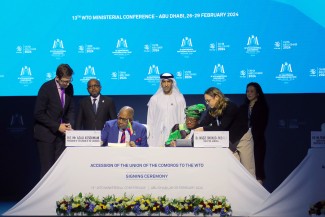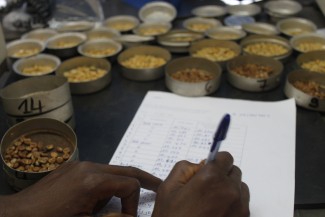Originally published in the Monitor on 19 April 2022.
A strategy of growing Uganda’s tourism exports, in particular crafts and souvenirs to at least $300,000, is in the pipeline. This, according to the Tourism Ministry, is taking place through quality assurance, better skills and standardising Uganda’s products.
Ms Doreen Katusiime, the Permanent Secretary in the Ministry of Tourism, Wildlife and Antiquities, says this will be achieved through channelling locally produced baskets, drums, jewellery, wood carvings, among others, online.
“We have developed websites for at least 10 indigenous enterprises that are involved in handicrafts and souvenirs. These are linked to our own website (at the Ministry of Tourism). We are hopeful that visibility and closing of deals will be possible for Ugandan products online,” Ms Katusiime says.
This deliberate drive of ensuring online presence of handicrafts and souvenirs is also expected to slow down the influx within the region and beyond of synthetic products imitating artefacts which are now on the rise.
The Ministry of Tourism hosts the handicraft and Souvenir Development project, which is supported by the Enhanced Integrated Framework (EIF); with among other objectives being improving quality, standards and marketing tourism exports such as souvenirs to boost foreign exchange.
Producers of handicrafts and souvenirs should use the new websites to improve on the quality of their products and ensure targeted marketing online. This move augments the drive to strengthen tourism dollar inflows; largely subdued by the effects of Covid-19 on the global leisure and hospitality industry.
“Lango Heritage centre works with local makers of crafts. We need to continue to add value to their efforts. We are one of the 10 enterprises selected and websites have been developed for us under the Handicraft and Souvenir Development Project,” says Mr John Have, the manager of Lango Heritage Centre.
Acknowledging the impact of this online marketing drive associated with tourism exports, Mr Have says, “This effort is adding value to our work in relation to marketing crafts that meet the demand for the international market. This means that unlike before, our products are visible across the world. When a souvenir is picked from Uganda, it must continue to meet international buyer expectation.”
Ms Katusiime emphasises, “Travellers always want souvenirs that are unique to Uganda. Therefore, you can’t divorce crafts from tourism.”
Clustering crafts
Given the special profile of products such as drums, baskets, cow horn, jewellery and more that are unique to each region of Uganda, clustering has been undertaken to ensure tailored interventions.
Mr Moses Byentaro, a team leader at Byentaro Ceramics, says, “We produce a range of ceramic products entirely out of clay which we harvest in a highly sustainable manner being mindful of the environment. Ugandan products are now competing very well against some synthetics items that we find in some places.”
Going online
A beneficiary of the Handicraft and Souvenir Development Project, Mr Byentaro adds, “We were lucky to be trained in various disciplines on how to better our products through diversity and quality. The presence online through websites is giving our business a competitive edge.”
“Initially, online was not our avenue. Now, it is increasing our exposure and it will likely lead us to more opportunities under international expos which is one of the roads towards expanding volumes and earnings,” Mr Byentaro says.
According to an online content developer and designer, Mr Dickson Mushabe, these companies are selling crafts and encountering increasing demand. Having their products online means one can easily see them, shop out for a basket, and drum or any souvenir. This increasing demand means these enterprises will be closing deals faster than looking forward physical shopping. So choice of products and payments are all done online.”
Creating jobs
Mr Mushabe, the regional manager, Hostalite East Africa, says active presence by Ugandan based producers and sellers of such handicraft and souvenirs, can give this sub-sector impetus for sustaining jobs and incomes.
This particular development in improving and streamlining of direct online presence and marketing of indigenous made handicraft and souvenirs, is seen as a potential tool in positioning Uganda’s exports.
Under the Handicraft and Souvenir Development Project, the Rwenzori Sustainable Trade Centre, one among the leading sellers of Ugandan made baskets in the international market, say that the online platform is now working wonders for them.
“Our partners Ngombe Womens’ Group, who are directly involved in the making of these baskets have greatly improved in the quality, standards and volumes. Our market has grown beyond Uganda and Africa to Europe and the United States,” says Ms Margarate Kas, the Manager.
She says the Fort Portal City based women’s organisation benefited from training on governance, standards and better skills in production which combined are now greatly easing the marketing of their baskets online.
“Organising ourselves in groups has been very effective in mobilising members to produce a near uniform standard of baskets. Our quality is also much better by the day. We now want to ensure as many buyers as possible are able to purchase our products online.” Mrs Kas, says.
According to the Ministry of Tourism, the handicraft and souvenir sub sector is part of the “Government’s efforts to diversify and increase exports of non- traditional exports while supporting increased job creation and employment as provided for in the Uganda Vision 2040, the National Trade Policy 2008 and the National Tourism Development Master Plan 2014/2024 among others.”
For Pace Blacksmithing Wood and Craft Association, there is need to enhance such tourism products that are a commonly produced by the communities in the north and west nile regions of the country.
“Our grandparents have always passed this knowledge to us from generation to generation. We mainly carve out art and crafts pieces of wildlife animals, indoor and outdoor decorations, furniture and various metal items out of blacksmithing,” said Mr Joseph Ocakacon, the Secretary of Pace Blacksmithing Wood and Craft Association, based in Packwach.
He adds that under the tourism export development project, they have been exposed to other competitive products made within the region during annual exhibitions such as the East African Jua Kali conventions in Arusha Tanzania.
“We are getting better by the day. We now know what products are on demand, what we need to do to make them better, how to price and how to use the internet and websites more effectively in promoting what we have,” argues Mr Ocakacon.
In Eastern Uganda, the Women in Entrepreneurship Development project based in Jinja City is also driving unique production of handicrafts and souvenirs made out of cow horns.
Ms Prossy Nankya says their enterprise, founded more than 15 years ago, has never had as much meaning as it does these days; two years after intense trainings in quality assurance under the Handicraft and Souvenir Development Project.
“We have upgraded some of the equipment that we use to design and produce various products such as cups, forks, spoons and other items out of cow horns. Our products are better. We now want to drive them into the international market,” Ms, Nankya.
In Mpigi District Mpambire Community Drum Makers Association also sources the cow hides and skins, a key material which they use in the making of various assortment of drums. Mr Isaac Buwule, the secretary of the association, says they have tackled selective sourcing of wood material taking cognisant of the environment.
“Even if we need money, we no longer just cut down trees for wood to make drums. We can also make more standardised drums, brand them very well and include price. We want to ensure buyers can and are able to tell the source,” says Mr Buwule.
In spite of the various remarkable outcomes that these various enterprises are realising under the Handicraft and Souvenir Development Project, virtually all of them await new standards on art and crafts pieces from the regulatory agency the Uganda National Bureau of Standards UNBS.
“We are closely working with the Uganda National Bureau of Standards UNBS, to ensure that the standards which are required for each of the products being made by our artisans across the country are ready. We need to ensure all the boxes for domestic, regional and international market compliance are fully ticked,” stresses Ms Katusiime.
If you would like to reuse any material published here, please let us know by sending an email to EIF Communications: eifcommunications@wto.org.



